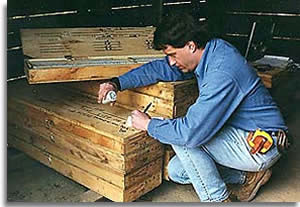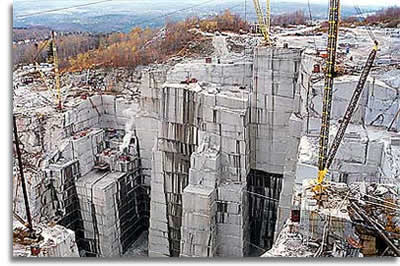|
 Attention
to detailed geology and careful logging of drill core have been
the hallmark of Geomapping's analysis of quarry potential. No quarry
deposit is uniformly the same stone throughout. Zonation changes,
stratigraphic variations, structural folding, and faulting are all
common features in a stone deposit. Once these parameters are mapped
and identified, the various stone types can be put to proper usage.
These variations are sometimes misidentified or misunderstood so
that the proper application of the stone becomes problematic. Too
many times, if this attention to detail is not applied early on
in the process of quarry development the problems, in turn, become
apparent after the stone has been delivered to the customer or the
job site and subsequent expensive corrective actions then need to
be taken. Attention
to detailed geology and careful logging of drill core have been
the hallmark of Geomapping's analysis of quarry potential. No quarry
deposit is uniformly the same stone throughout. Zonation changes,
stratigraphic variations, structural folding, and faulting are all
common features in a stone deposit. Once these parameters are mapped
and identified, the various stone types can be put to proper usage.
These variations are sometimes misidentified or misunderstood so
that the proper application of the stone becomes problematic. Too
many times, if this attention to detail is not applied early on
in the process of quarry development the problems, in turn, become
apparent after the stone has been delivered to the customer or the
job site and subsequent expensive corrective actions then need to
be taken.
There are many new production methods available for
quarrying. The stone characteristics, as well as, the logistics
of each quarry site will dictate the suitability of a particular
system. The use of torches, drills, wire saws, or chain saws is
determined by the cutting and splitting characteristics of the stone.
The spacing and pattern of fractures and joint systems are primary
considerations in quarry design.
 The
handling systems that are selected are dependent on both the configuration
of the deposit and the topography of the quarry site. In many instances,
the derrick system is still the preferred method of moving quarry
blocks. Most open pit type quarries, where the deposit is exposed
at the ground surface over an extended area, utilize ramp roads
and front end loaders or fork lifts for block handling and disposal
of quarry waste rock. The
handling systems that are selected are dependent on both the configuration
of the deposit and the topography of the quarry site. In many instances,
the derrick system is still the preferred method of moving quarry
blocks. Most open pit type quarries, where the deposit is exposed
at the ground surface over an extended area, utilize ramp roads
and front end loaders or fork lifts for block handling and disposal
of quarry waste rock.
Geomapping's experienced staff of professional geologists
have the knowledge to determine the most cost effective quarry development
and production system for your quarry site.
Shipping quarry blocks from Vermont to Italy for finishing,
and selling Utah river boulders for colorful pavers west of the
Mississippi are both good indications of the current demand for
dimension stone. Making the most of a stone deposit is one of the
keys to being profitable. Developing a local market for secondary
quality stone and random block sizes often helps off-set the cost
of quarrying. Knowing the percentage of a deposit that will yield
top quality blocks suitable for making full sized slabs is a key
element in preparing a realistic business plan for your quarry.
This is one of the many areas in which Geomapping's geologists can
apply their in-depth experience to your project.
 The
geology of the stone deposit, development & production methods,
operating costs, transportation & handling, and market demand
are all important design considerations which are incorporated into
Geomapping's integrated approach to quarry planning. The
geology of the stone deposit, development & production methods,
operating costs, transportation & handling, and market demand
are all important design considerations which are incorporated into
Geomapping's integrated approach to quarry planning.
|



